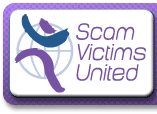
 |
|
|
|
|
|
|
|
|
|
|
|
|
|
|
|
|
|
|
|
|
|
|
|
|
|
|
|
Counterfeit Cashier's Check Victims - Find out where to report these scams How the scam works . . . You are selling an item over the Internet - it could be a used car or motorcycle, jewelry or even bred animals. You receive an email offer to purchase your item and the buyer says he'll send a bank cashier's check. The buyer is from Nigeria or "West Africa", but has a business associate in the United States who will send you the cashier's check. Then you are told that for some reason the check was already made out to you for an amount larger than your asking price. The buyer asks you to please deposit the check, wait for it to clear, and then send him the difference -- "but only after the cashier's check clears, of course." You are skeptical - but, sure enough, the bank cashier's check arrives by Fed Ex, it looks real, your bank accepts the check, and the bank assures you the funds are in fact available. So you wait the time the bank recommends to verify that the check is clear and then you wire the difference to your buyer in Nigeria and prepare to ship your item. A week later your bank calls: "We're very sorry, but the cashier's check was counterfeit" -- a superb copy, but worthless. Your account is frozen. You must pay the bank back the entire amount of the cashier's check. You may even be considered a fraud suspect yourself. Your "buyer" disappears. About the only good news: sellers
rarely get to the point of shipping their items abroad. How to Protect Yourself If you are selling online, be extremely skeptical of any offers
Also, a bank may make money "available" to you almost at once if you deposit a purported bank cashier's check, but that's NOT a guarantee the check is authentic. It could be returned as counterfeit up to three years later, and the bank will hold you responsible for the money. Ways to verify a check include:
More Information ____________________________________________________________ Copyrightę 2009 Scam Victims United Designed by: Disclaimers, Message Board Guidelines and Privacy Policy
|